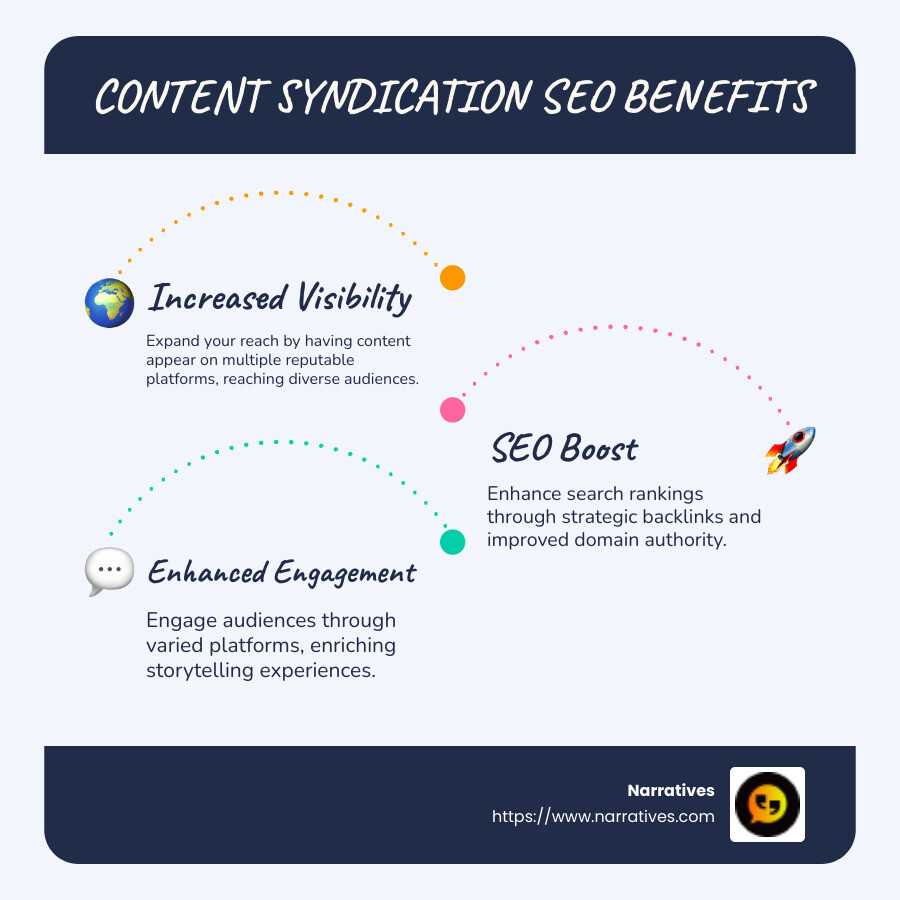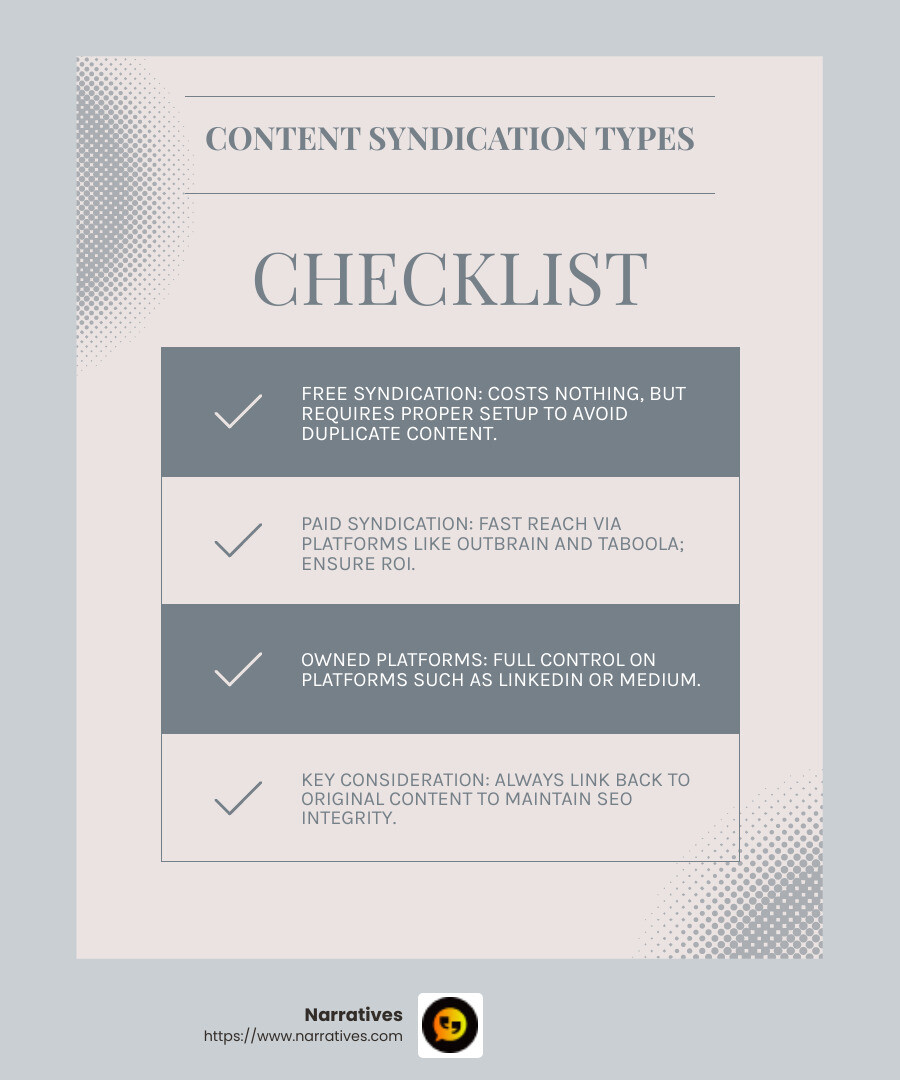Syndication and SEO: A Match Made in Digital Heaven

Content syndication SEO is more than just a buzzword; it's a powerful strategy that marries the art of storytelling with the science of search engine optimization. For non-profits and social impact organizations that cherish their mission, grasping this concept can transform how they engage audiences and amplify their stories.
If you're aiming for a quick understanding of the essentials, here's what you need to know:
Increased Visibility: Syndicating content across multiple reputable sites can widen your reach far beyond your initial audience.
SEO Boost: Properly managed content syndication improves your SEO through backlinks and improved domain authority.
Improved Engagement: Sharing your message through diverse platforms enriches your digital storytelling and improves engagement.
Content syndication allows your valuable content to be featured on established platforms, increasing visibility and building authority. When executed with SEO best practices, such as using canonical tags, it ensures that your original webpage maintains its search engine ranking. Consequently, your narratives resonate more, supporting your organization's mission and attracting support or donations.
For non-profit marketing leaders overwhelmed by resource constraints, understanding content syndication can solve new paths to share impactful stories effectively.

Simple content syndication seo glossary:
What is Content Syndication?
Content syndication is a clever way to share your digital content with a wider audience. Imagine your blog post, video, or infographic appearing on multiple third-party sites. That's content syndication in action!
Republishing Content
The essence of content syndication is republishing. You take a piece of content from your website and allow other platforms to share it. This isn't about creating something new for each site—it's about maximizing the reach of what you already have.
Third-Party Sites
Third-party sites are the key players in content syndication. These are platforms that agree to feature your content. They might publish your article in full or just a snippet with a link back to your original post. This way, they get quality content without the effort of creating it, and you get more eyes on your work.
Digital Content
Any type of digital content can be syndicated. Whether it's blog posts, articles, videos, or infographics, the goal is to extend the life and reach of your content.
This approach not only improves your visibility but also strengthens your authority in your field. When your content appears on reputable sites, it signals to readers—and search engines—that you're a trusted source of information.
Content syndication is about spreading your story far and wide, ensuring that your message reaches as many people as possible. With the right strategy, it can be a game-changer for your digital presence.
Benefits of Content Syndication for SEO
Content syndication isn't just about getting your message out there—it's also a powerful tool for boosting your SEO. Let's explore how it can improve brand awareness, generate valuable backlinks, and build your authority in your field.
Brand Awareness
Imagine your content being featured on popular websites and platforms. This exposure doesn't just increase traffic to your original content; it also amplifies your brand's visibility. When your content appears on well-known sites, more people become familiar with your brand. It's like having a digital billboard in a busy city square.
Backlinks
Backlinks are a big deal in SEO. They act like votes of confidence from one site to another. When your syndicated content includes links back to your original site, it tells search engines that your content is valuable. The more high-quality backlinks you have, the better your site can rank in search results.
Interesting Fact: A single high-quality backlink can be more valuable than dozens of low-quality ones. That's why syndicating content on reputable sites is key.
Authority Building
Content syndication helps establish you as an authority in your niche. When your content is shared across respected platforms, it signals to both readers and search engines that you know your stuff. This boosts your credibility and trustworthiness, which can lead to higher search rankings and more engaged audiences.
In summary, content syndication is a win-win for both brand visibility and SEO performance. By strategically sharing your content on third-party sites, you not only reach wider audiences but also strengthen your digital reputation.
Next, we'll explore how to implement content syndication SEO effectively, ensuring your strategy is both impactful and sustainable.
How to Implement Content Syndication SEO
Implementing content syndication SEO effectively requires a thoughtful strategy. Let's explore key practices to ensure your syndicated content boosts your SEO without falling into common traps.
Canonical Tags
Canonical tags are essential when syndicating content. They help search engines understand which version of your content is the original. This prevents duplicate content issues that can harm your rankings.
Why Use Canonical Tags?
When you syndicate content, the third-party site should include a canonical tag pointing to your original article. This tells search engines to prioritize your version in search results.How to Implement:
Work with your syndication partners to ensure they add the correct canonical tags. This simple step can safeguard your SEO efforts.
Backlink Strategies
Backlinks are a cornerstone of SEO, and syndication offers a unique opportunity to build them.
Link Back to Your Original Content:
Always ensure that syndicated content includes a link back to the original article. This not only drives traffic but also signals to search engines that your content is authoritative.Select High-Quality Partners:
Choose syndication partners with strong domain authority. A backlink from a reputable site is far more valuable than several from lesser-known sites.
SEO-Friendly Practices
To make the most of content syndication, follow these SEO-friendly practices:
Track Performance:
Use tools to monitor how syndicated content is performing. Track metrics like referral traffic and backlink quality to measure success.Optimize Content for Syndication:
Before syndicating, ensure your content is optimized with relevant keywords. This can improve its visibility on both your site and the syndication partner's platform.Maintain Consistent Quality:
High-quality content is more likely to be shared and linked back to. Ensure your content is engaging, informative, and polished before syndicating it.
Implementing these strategies will help you make the most of your content syndication SEO efforts. By using canonical tags, building effective backlink strategies, and adhering to SEO-friendly practices, you can improve your digital presence and drive significant traffic back to your original content.
Next, we'll dig into the different types of content syndication available and how to choose the best options for your goals.
Types of Content Syndication
When it comes to content syndication, you have three primary avenues to explore: free syndication, paid syndication, and owned platforms. Each type offers unique advantages and can be custom to fit your objectives and resources.
Free Syndication
Free syndication is straightforward and cost-effective. It involves sharing your content with third-party websites at no cost. The key here is to find the right partners who are willing to republish your content with proper attribution.
How to Find Partners:
Look for websites that already syndicate content. Search for phrases like "originally appeared on" or "republished with permission" to identify potential partners.Benefits:
Free syndication can help you reach a broader audience without spending a dime. It also provides valuable backlinks, which can boost your SEO.Considerations:
Ensure that your partners use canonical tags and link back to your original content. This helps maintain your search engine rankings and avoid duplicate content issues.
Paid Syndication
Paid syndication is a more controlled approach. It involves paying platforms to distribute your content to a wider audience. This method is often used by companies looking to increase their reach quickly.
Platforms to Consider:
Services like Outbrain and Taboola are popular choices for paid syndication. They place your content on high-traffic sites, increasing visibility.Benefits:
Paid syndication can drive substantial traffic to your site and is particularly useful for promoting time-sensitive content or campaigns.Considerations:
While effective, paid syndication can be costly. It's important to set a clear budget and measure the return on investment (ROI) to ensure it's a worthwhile expense.
Owned Platforms
Owned platforms offer full control over your content syndication efforts. This involves republishing your content on platforms you own or manage, such as LinkedIn or Medium.
How to Leverage Owned Platforms:
Simply repost your content on these platforms, ensuring you link back to the original source. This not only boosts visibility but also helps drive traffic to your website.Benefits:
Owned platforms allow you to maintain control over how your content is presented and shared. They also provide another channel to engage with your audience.Considerations:
While this method is cost-effective, it requires ongoing management and engagement to maximize its potential.
By understanding these types of content syndication, you can select the best approach to meet your specific goals. Whether you opt for free syndication, invest in paid options, or use owned platforms, each method can improve your content syndication SEO strategy.

Next, let's address some common questions about content syndication SEO, including its impact on search rankings and potential plagiarism concerns.
Frequently Asked Questions about Content Syndication SEO
How does content syndication affect SEO?
When you hear about content syndication, one of the first concerns is often about duplicate content. Google doesn't favor identical content scattered across the web. Its goal is to provide diverse and unique search results. If your syndicated content is seen as a duplicate, it could affect your search rankings.
However, there's good news! You can avoid these pitfalls by using canonical tags. These tags tell search engines which version of the content is the original, helping to maintain your site's authority and avoid penalties. Also, ensure that your syndication partners link back to your original article. This not only boosts your SEO but also helps Google understand the hierarchy of the content.
Can content syndication lead to plagiarism issues?
The short answer is no, not if done correctly. Content syndication is all about awareness and consent. Unlike plagiarism, which is unauthorized copying, syndication is a mutual agreement where both parties benefit.
To ensure transparency, always credit the original source. This can be as simple as adding a line like "Originally published on [Your Website]" with a link back. This practice not only avoids plagiarism concerns but also builds trust with your audience.
What are the best platforms for content syndication?
Choosing the right platform for syndication can significantly impact your reach and engagement. Here are some top platforms to consider:
LinkedIn:
Perfect for B2B content, LinkedIn allows you to republish articles and reach professionals in your industry. It's a great way to engage with a professional audience and drive traffic back to your site.Medium:
Medium is known for its engaged readership and easy-to-use interface. Republishing your content here can help you reach a diverse audience interested in a variety of topics.YouTube:
If your content includes videos, YouTube is an excellent platform for syndication. It has a massive user base and can significantly boost your visibility. Plus, video content often ranks well in search results.
By carefully selecting platforms like LinkedIn, Medium, and YouTube, you can maximize the benefits of your content syndication SEO efforts. Each platform offers unique advantages, so choose based on where your audience is most active.
Next, we'll explore how to implement content syndication SEO effectively, focusing on canonical tags, backlink strategies, and other SEO-friendly practices.
Conclusion
In digital storytelling, content syndication is a powerful ally, especially for non-profits and purpose-driven organizations like us at Narratives. Our mission is to amplify underrepresented voices through compelling video and multimedia content. By leveraging content syndication SEO, we can extend the reach of these impactful stories, ensuring they inspire action and build trust across broader audiences.
At Narratives, we understand the importance of a robust SEO strategy. Our approach focuses on establishing domain authority by owning storytelling-related keywords that are often overlooked. This strategy not only differentiates us from competitors but also aligns perfectly with our commitment to community-driven storytelling.
By carefully selecting syndication partners and platforms, we can improve our brand awareness and increase our online visibility. Platforms like LinkedIn and Medium allow us to share our content with engaged audiences, while canonical tags and backlink strategies help maintain our site's authority.
For non-profits, the benefits of content syndication are clear. It helps build credibility, attract more supporters, and ultimately drive meaningful engagement with the communities they serve. As we continue to explore innovative ways to share these stories, we remain committed to using content syndication as a long-term investment in our SEO strategy.
Ready to lift your storytelling and impact? Learn more about how Narratives can help you share your story with the world. Start your journey with us today.



